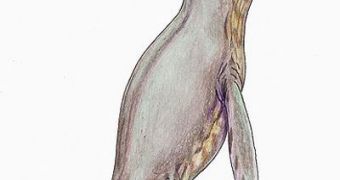While digging at a site on the UK coasts, experts recently came across the bones of a pliosaur. While some may consider it just another dinosaur, for experts, it is one of the most important and amazing finds of the last few years. The aquatic animal was a monster, they say, one that would have made Tyrannosaurus Rex look like a harmless puppy. The massive creature roamed the oceans more than 150 million years ago, and fed on everything that was unfortunate enough to come in its path, including other pliosaurs, the BBC News reports.
“I had heard rumors that something big was turning up. But seeing this thing in the flesh, so to speak, is just jaw dropping. It is simply enormous,” Richard Forrest, a paleontologist, said. The skull is more than 2.4 meters in length by itself, which means that it may have belonged to one of the largest specimens of pliosaurs ever discovered, an individual that might have measured about 16 meters (52.5 feet) in length. That is big by any standard, and these measurements dwarf those of orca whales.
“These creatures were monsters. They had massive big muscles on their necks, and you would have imagined that they would bite into the animal and get a good grip, and then with these massive neck muscles they probably would have thrashed the animals around and torn chunks off. It would have been a bit of a blood bath,” University of Portsmouth paleontologist Dr. David Martill adds. The pliosaur had four paddle-like limbs, which it used to propel its massive and bulky body through the water. The great muscle mass helped it move fast and also keep a hold on the prey it seized.
According to the initial measurements of the skull, it would appear that this specific pliosaur may have weighed between seven and 12 tonnes. “We only have the head, so you cannot be absolutely precise. But it may be vying with the ones found in Svalbard and Mexico for the title of the world's largest,” Martill adds. The expert team says that most of the fossil is still in its rocky form, but adds that it has been exceptionally well preserved for its age.
“Pliosaur skulls are very big, but not that robust, in general, and you tend to find them crushed flat – completely 'pancaked.' What is fantastic about this new skull, not only is it absolutely enormous, but it is pretty much in 3D and not much distorted,” pliosaur expert Richard Forrest adds.
The fossil was found on the coast line between Dorset and East Devon, an area spanning more than 185 million years of evolution. Because the “Jurassic Coast” is constantly eroding, chunks of rocks containing all sorts of fossils keep falling off onto the beach. The private collector that found the pliosaur head was lucky enough to have been on the beach at the time of the landslide and recuperate the ancient beast's remains. The Coast is considered a World Heritage Site by UNESCO.

 14 DAY TRIAL //
14 DAY TRIAL //